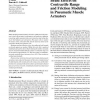Free Online Productivity Tools
i2Speak
i2Symbol
i2OCR
iTex2Img
iWeb2Print
iWeb2Shot
i2Type
iPdf2Split
iPdf2Merge
i2Bopomofo
i2Arabic
i2Style
i2Image
i2PDF
iLatex2Rtf
Sci2ools
IJRR
2006
2006
Braid Effects on Contractile Range and Friction Modeling in Pneumatic Muscle Actuators
Within braided pneumatic Muscle Actuators (pMA) the braid structure is vital to the actuator's performance, preventing over-inflation, converting radial expansion into axial contraction and setting limits for both dilation and contraction. This paper seeks to explore the nature of the contractile limit and the hysteresis observed by researchers during the actuation cycle. Maximum actuator dilation occurs when adjacent braid strands are forced against one another. Within this work this is analyzed mathematically and it is shown that by halving the number of strands used to create the braided shell the actuator's contractile range can be increased by approximately 7%. This also results in a simultaneous peak contractile force increases of over 16%. These results are verified experimentally. Hysteresis due to friction between braid strands during muscle operation is also explored. The paper will show how consideration of the deformation of the strands allows the contact area an...
| Added | 13 Dec 2010 |
| Updated | 13 Dec 2010 |
| Type | Journal |
| Year | 2006 |
| Where | IJRR |
| Authors | Steve Davis, Darwin G. Caldwell |
Comments (0)

